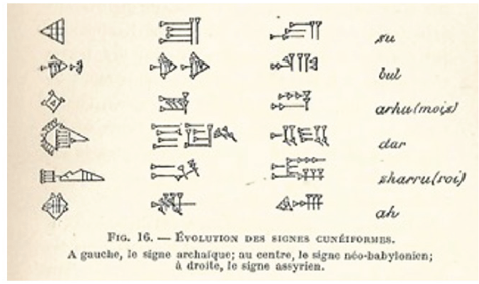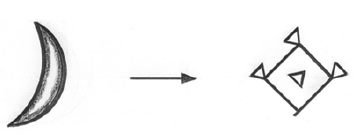- Submissions

Full Text
Archaeology & Anthropology:Open Access
The Origin and Nature of Time Explained by Archaeology
Patrice F Dassonville*
Freelance Researcher, France
*Corresponding author: Patrice FD, Freelance Researcher, Author of the Invention of Time & Space, Springer 2017, France
Submission: January 10, 2023Published: February 09, 2023

ISSN: 2577-1949 Volume4 Issue4
Abstract
The importance of «time» for humanity leads to the need for in-depth research about the origin and the use of «arhu» (lunar month) in the cuneiform literature.
Keywords:Cuneiform; Lunar month; Sumer
Introduction
It would be of a great interest if some archaeologists could look for sentences involving
the archaic sign «arhu» (lunar month), for various purposes :
a. Find out the way Sumerians began to use «arhu»
b. Observe the development and the frequency of its use
c. Figure out why Sumerians decided to measure their activities in relation to that of
the Moon.
d. Elucidate the origin of the strange shape of this archaic sign..
The Oldest Trace of Temporality
Figure 1:Evolution of cuneiform signs. On the left, the archaic sign at the center, the neo-Babylonian sign; on the right, the Assyrian sign.

Nobody is able to imagine our current life without time, because time is everywhere: in everyday life, in the humanities and exact sciences; only mathematics escapes its grasp. Paradoxically, time has always resisted attempts at definition, as well as investigations into its nature and properties. Faced with the failure of philosophers and scientists, I proceeded differently by looking for traces of time since the birth of writing in Sumer about 2800 and 2500 BCE (Before Common Era) [1]. In «La civilisation d’Assur et de Babylone», Dr Conteneau, curator of Antiquités Orientales at the Musée du Louvre, shows the evolution of cuneiform signs (Figure 1); the third line is about the month (arhu) [2] ; «arhu» should be considered a significant step forward, because it sounds like the oldest trace of temporality ever displayed.
The Approach of Sumerians
It is crucial to keep in mind the difference between a reality and the corresponding concept : a concept is not observable, not measurable, without possible experiments on it; while a reality is observable, measurable, with possible experiments on it. As an illustration, Eve has always been drawn and painted with a navel; but Eve’s navel is an anachronism: well, we see her navel which is a reality, but we can’t see the anachronism because it is a concept! My analysis led me to consider that the Sumerian scholars observed the repetitions of the movements of the moon (Figure 2), which is a reality ; then they gave the name «arhu» to what is between two repetitions, which is a concept; and they gradually used «arhu» in their everyday life. Obviously, it allowed them to improve the organization of their life. Example : «The travel will last two arhu». Upon my knowledge, «arhu» is a major invention because it proves that the month is not a phenomenon, instead, it’s a concept invented by Sumerian scholars. The same approach allows us to demonstrate that the day, the year, and time at large, are concepts. But we seriously need to learn more about «arhu».
Figure 2:From a reality observed to the invention of the month.

Need More!
Given the significance of the issue, this interpretation needs to be vetted: for example, it’s crucial to find out how Sumerians started using «arhu», in what circumstances, in what field of activity they began to use it. Can we find some examples of its use? Do they give any explanation, any opinion, any comments, about their amazing invention? Such an extensive investigation requires a large inventory through thousands of tablets that are preserved in museums, and that could tell us more. Note that if «arhu» was not the very first graphic sign of temporality, it wouldn’t really matter, because it’s the analysis of the approach, the results of this analysis and the various consequences, that matter.
Conclusion
Without knowing it, archeology has a prominent involvement in the study of time : it’s a good example of the effectiveness of multidisciplinary. Physicists and philosophers thought they could do without multidisciplinary; but they failed to define time, to describe its nature and properties. Of course, multidisciplinary raises difficulties in term of communication between stakeholders, but the result, quite unexpected, is there. Nevertheless, I am convinced that we can get more from archaeologists to whom I make an unusual appeal, on the understanding that I would provide the assistance as an ordinary physicist. The topic is neither more nor less than the origin of time.
References
- André LB, Ziegler C (1982) Birth of writing. National Museums, Paris.
- Conteneau G (1937) The civilization of Assur and Babylon. Paris.
© 2023 Patrice F Dassonville. This is an open access article distributed under the terms of the Creative Commons Attribution License , which permits unrestricted use, distribution, and build upon your work non-commercially.
 a Creative Commons Attribution 4.0 International License. Based on a work at www.crimsonpublishers.com.
Best viewed in
a Creative Commons Attribution 4.0 International License. Based on a work at www.crimsonpublishers.com.
Best viewed in 







.jpg)






























 Editorial Board Registrations
Editorial Board Registrations Submit your Article
Submit your Article Refer a Friend
Refer a Friend Advertise With Us
Advertise With Us
.jpg)






.jpg)














.bmp)
.jpg)
.png)
.jpg)










.jpg)






.png)

.png)



.png)






